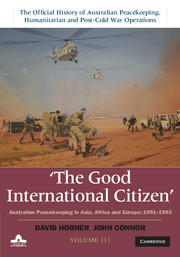Book contents
- Frontmatter
- Contents
- Maps
- Preface
- Chronology 1989–99
- Abbreviations
- Part 1 Strategy and policy
- Part 2 Cambodia
- 3 From Angkor Wat to Pol Pot
- 4 Law and order on the border
- 5 An Australian peace proposal
- 6 First into Phnom Penh
- 7 The roadblock
- 8 Change in plan
- 9 ‘Democracy's surprise triumph’
- 10 Developing Operation Banner
- 11 Winding up Operation Banner
- Part 3 Western Sahara
- Part 4 Former Yugoslavia
- Part 5 Watch on Iraq
- Appendix A United Nations Security Council resolutions
- Appendix B Major office bearers, 1991–99
- Bibliography
- Index
- Plate section
- References
10 - Developing Operation Banner
Australian military assistance to Cambodia, 1994–97
from Part 2 - Cambodia
Published online by Cambridge University Press: 12 May 2022
- Frontmatter
- Contents
- Maps
- Preface
- Chronology 1989–99
- Abbreviations
- Part 1 Strategy and policy
- Part 2 Cambodia
- 3 From Angkor Wat to Pol Pot
- 4 Law and order on the border
- 5 An Australian peace proposal
- 6 First into Phnom Penh
- 7 The roadblock
- 8 Change in plan
- 9 ‘Democracy's surprise triumph’
- 10 Developing Operation Banner
- 11 Winding up Operation Banner
- Part 3 Western Sahara
- Part 4 Former Yugoslavia
- Part 5 Watch on Iraq
- Appendix A United Nations Security Council resolutions
- Appendix B Major office bearers, 1991–99
- Bibliography
- Index
- Plate section
- References
Summary
Between 1994 and 1999 more than a hundred ADF personnel served in Cambodia as part of Operation Banner. This operation covered a broad range of activities that included support for the Cambodian Mine Action Centre (a humanitarian task); projects under the ADF's Defence Cooperation Program (DCP), such as installing communications for the Royal Cambodian Armed Forces, maintenance training for the Cambodian Navy and language instruction; and a separate counterinsurgency training program. DCP projects would not normally be included in this history, but those in Cambodia were different. After decades of war and conflict and the withdrawal of the UN Transitional Authority in Cambodia (Untac), the new Cambodian Government and its armed forces faced seemingly insurmountable challenges. The ADF projects, described in this chapter, aimed to help the Cambodians to rebuild their nation.
In his 1992 report An Agenda for Peace, the UN Secretary-General, Boutros Boutros-Ghali, declared that post-conflict peace-building was as important as preventive diplomacy, peacemaking and peacekeeping. ‘To be truly successful’, he explained, peacemaking and peacekeeping operations ‘must come to include comprehensive efforts to identify and support structures which will tend to consolidate peace and advance a sense of confidence and well-being among people.’ He emphasised the need to ‘address the serious problem of land mines, many tens of millions of which remain scattered in present or former combat zones’. The ADF's largest and most important activity in Cambodia after the withdrawal of Untac was support to the demining program, under the auspices of the UN Development Program, while its other activities helped to build and support the Cambodian Government, including its armed forces.
- Type
- Chapter
- Information
- The Good International CitizenAustralian Peacekeeping in Asia, Africa and Europe 1991–1993, pp. 225 - 249Publisher: Cambridge University PressPrint publication year: 2014

